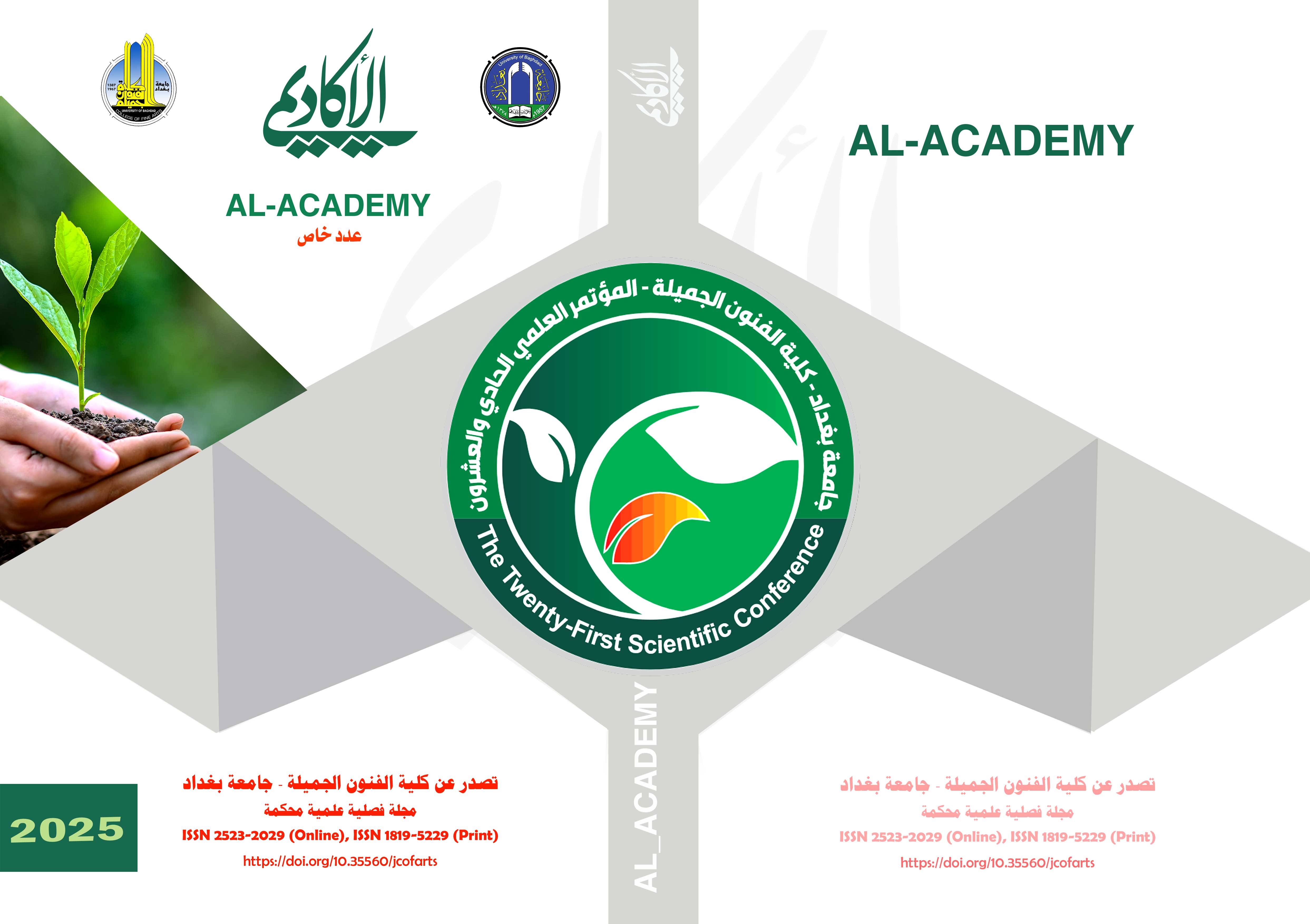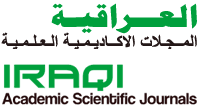The role of visual symmetry between contemporary art and AI-generated methods in promoting sustainable visual culture.
DOI:
https://doi.org/10.35560/jcofarts1630Keywords:
Artificial Intelligence, Sustainable Development, Visual CultureAbstract
The current research addresses the role of visual symmetry between contemporary art and methods generated by artificial intelligence in promoting sustainable visual culture. Visual symmetry embodies the convergence in compositional structures between human artistic expression patterns and those generated by intelligent algorithms, which opens new horizons in redesigning the aesthetic and visual awareness of the recipient. The current research seeks to answer the following question: What is the role of visual symmetry between contemporary art and methods generated by artificial intelligence (AI) in promoting sustainable visual culture? The aim of the research was to reveal the role of visual symmetry between contemporary art and methods generated by artificial intelligence (AI) in promoting sustainable visual culture. The chapter concludes by defining the boundaries of the research and defining the terms. The second chapter included four main topics: the first topic: pictorial symmetry; the second topic: sustainable development; the third topic: visual culture and its relationship to sustainable development; and the fourth topic: cultural symmetry between artificial intelligence and art. The chapter concluded with indicators of the theoretical framework.
The third chapter dealt with the research methodology and procedures. The researchers defined their research community as (261) male and female students from Iraqi universities (Baghdad, Babylon, and Al-Mustansiriya), in the art education departments, for the academic year (2024-2025 AD). The research sample was defined as (100) male and female students. A scale consisting of (25) artworks was designed and applied to the research sample. In the fourth chapter, the researchers reviewed the most prominent results of the research, including: There is a clear tendency among students at the universities of Baghdad and Babylon to prefer original paintings, while students at Al-Mustansiriya University showed a convergence in preference between original paintings and those produced by artificial intelligence. This indicates that sustainable visual culture may be linked to environmental or cognitive factors that vary from one university to another, opening the door to deeper analytical studies to explore the determinants of visual taste and interaction with digital arts. The research conclusions were: that students distinguished between "mastery" and "meaning." Despite the technical precision of artificial intelligence, it does not possess the emotional memory or cultural reference of a human artist. This is an indicator of the sustainability of critical taste in the face of technical fascination, the limitations of artificial intelligence in expressing symbolic depth, and the students' appreciation of works that carry value and a message, whether original or digital.
References
Abdel Azim Hamza Al-Obaidi (2020). Tributaries of Smart Life, 1st ed. Amman: Dar Al-Radwan Publishing and Distribution.
Abdel Masih Semaan Abdel Masih (2017). Sustainable Development: The Nineteenth Scientific Conference: Science Education and Sustainable Development. Cairo, Egypt: Egyptian Society for Science Education.
Abdullah bin Abdul Rahman Al-Baridi (2015). Sustainable Development: An Integrative Approach to Sustainability Concepts and Their Applications with a Focus on the Arab World. Riyadh, Saudi Arabia: Al-Obeikan.
Ali Abdul Karim Hussein Al-Jabri (2012). The Role of the State in Achieving Sustainable Human Development in Egypt and Jordan. Amman, Jordan: Dar Dijlah Publishers and Distributors.
Francis Dwyer and David Mike Moore. (2015). Visual Culture and Visual Learning, translated by Nabil Jad Azmi, second edition. Cairo, Egypt: Beirut Library.
Gro Harlem Brundtland. (1987). Report of the World Commission on Environment and Development: Our Common Future. United Nations World Commission on Environment and Development.
Group-Authors. (2016). The Changing Role of the Teacher, Educational Futures, Issue Six, Volume Two. Al-Shamiya-Kuwait: Arab Center for Educational Research for the Gulf States.
Hazem Abboudi Al-Saeedi, (2018). Philosophical Representations in Sculptural Pottery from the Civilizations of Ancient Iraq and Egypt. Damascus, Syria: Academic Book Center for Publishing and Distribution.
Ilham Younis Ahmed, (2021). Sustainable Development and Political Empowerment: The Reality of Arab Women. Cairo, Egypt: Al-Arabi Publishing and Distribution.
Iman Younis Ibrahim Al-Abbadi, (2020). Visual Perception in Kindergarten Children. Amman, Jordan: Academic Book Center.
Iyad Muhammad Al-Saqr, (2010). The Meaning of Art. Baghdad, Iraq: Dar Al-Mamoun for Translation and Publishing.
Kamel Hassoun Al-Qayem. (2007). Approaches and Methods of Writing Scientific Research. Baghdad: Al-Sima Designs and Printing.
Kerry J. Freedman. (2003). Teaching Visual Culture- Curriculum, Aesthetics, and the Social Life of Art. USA- New York: Teachers College Press.
Maher Aziz. (2009). Nuclear Power... and Sustainable Development. Egypt: Academic Library.
Majid Fadel Al-Zboon. (2013). Media and the Culture of Deconstruction. Cairo, Egypt: Al-Arabi Publishing and Distribution.
Medhat Abu Al-Nasr, and Yasmine Medhat Muhammad. (2017). Sustainable Development - Its Concept, Dimensions, and Indicators. Cairo, Egypt: Arab Group for Training and Publishing.
Mohammed Abu Al-Khair. (2021). Arts and Citizenship, published by Muhammad Hamed Abu Al-Khair
Mohsen Ali Attia. (2014). Metacognitive Strategies in Reading Comprehension, first edition. Amman, Jordan: Dar Al-Manahij for Publishing and Distribution.
Muhammad Al-Taiti and others. (2018). Production and Design of Educational Media. Amman, Jordan: Dar Alam Al Thaqafa for Publishing.
Muhammad Hamid Mahdi Al-Masoudi, et al. (2025). Diversification of Traditional and Modern Electronic Teaching, 1st ed. Amman, Jordan: Dar Al-Manhajiyya for Publishing and Distribution.
Muhammad Hassan Abu Qata. (2025). Management of Educational Institutions: Influential Theories and Trends, 1st ed. Tanta, Egypt: Al-Furqan Library.
Munira Misbah. (2004). Dialogues and Insights into Half a Century of Politics, Thought, Literature, and Art, First Edition. Beirut, Lebanon: Arab Foundation for Studies and Publishing. Nasser Al-Jabar (2011). Image Culture in the Media, 1st ed. Cairo, Egypt: Egyptian Lebanese House.
Mustafa Attia Jumaa. (2017). Islam and Sustainable Development, Rooted in the Light of Jurisprudence and its Principles, 1st ed. Cairo, Egypt: Shams Publishing and Media.
Mustafa Youssef Kafi. (2017). Sustainable Development. Amman, Jordan: Dar Al-Akademoon for Publishing and Distribution.
Nevenka Korica Sullivan. (2022). Advanced Arabic through Discussion. American University in Cairo Press.
Rand Hazem Agha, (2011). Architectural Technology and Interior Design. Amman, Jordan: Majdalawi Publishing and Distribution.
Shaker Abdel Hamid (2007). Visual Arts and the Genius of Perception, First Edition. Cairo, Egypt: Dar Al Ain Publishing.
Sherif Saeed Abdel Gawad (2020). Know Yourself. BD: BN.
Tayseer Najm Al-Din Al-Nashef, (2014). Society and Culture, first edition. Amman, Jordan: Dar Al-Mamoun for Publishing and Distribution.
Terry Eagleton, (2018). Culture, translated by Latifiya Al-Dulaimi, first edition. Baghdad, Abu Nuwas District: Al-Mada Publishing House, Culture, and Arts.














